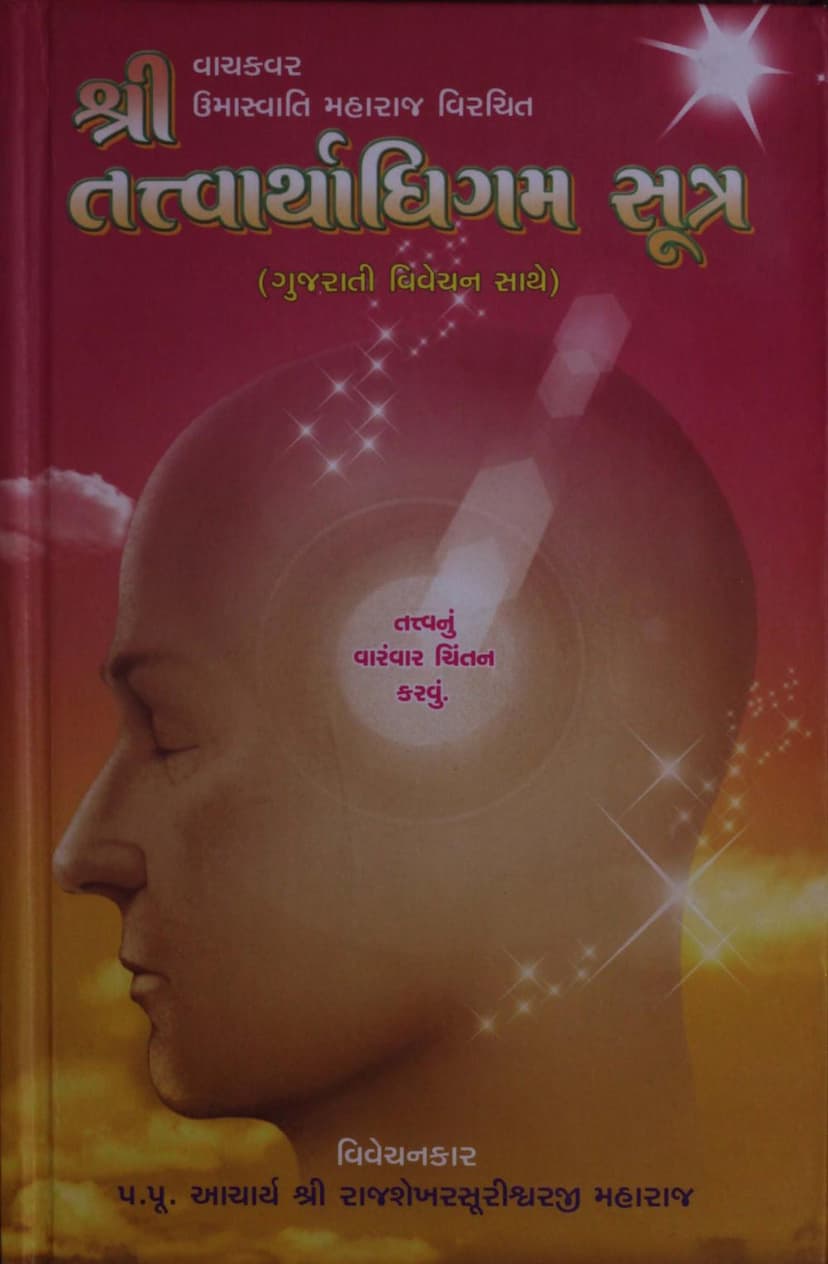Tattvarthadhigama Sutra
Added to library: September 2, 2025

Summary
The Tattvarthadhigama Sutra, authored by Acharya Umaswati (also known as Tattvarthasuri), is a foundational text in Jain philosophy, revered by both Shvetambara and Digambara traditions. This particular edition includes a Gujarati commentary by Pujya Acharya Rajshekharsurishwarji Maharaj, highlighting its importance in the Shvetambara tradition. The publisher is Shrimad Yashovijayji Jain Sanskrit Pathshala, Mehsana, indicating its academic and devotional value.
The Tattvarthadhigama Sutra is highly regarded for its comprehensive and systematic exposition of Jain principles, covering the entire spectrum of Jain teachings. It is considered a concise yet profound summary of the Jain path to liberation, known as Moksha. The text is structured into ten chapters, each delving into critical aspects of Jain ontology, epistemology, and ethics.
Here's a chapter-wise breakdown based on the provided text:
Overall Significance and Structure:
- The Tattvarthadhigama Sutra is considered paramount in Jainism, systematically explaining the core principles of the faith. It is revered across both major Jain traditions.
- The author, Umaswati, is acknowledged as a significant figure whose work is central to understanding Jain philosophy.
- The text is praised for its ability to clarify complex Jain concepts, making them accessible to a wide audience, including students and scholars.
- The commentary by Acharya Rajshekharsurishwarji Maharaj aims to simplify the subject matter, making it understandable for those with moderate intellectual capacity.
- The Sutra is noted for its brevity, containing fewer than 200 verses, yet encompassing all fundamental elements of Jain philosophy, earning it the title "collection of essentials" or "Ah-vachana Sangraha".
Chapter Summaries:
- Chapter 1 (Sammyak-darshan, Jnan, Tattvas): Introduces the concept of the path to liberation (moksha) through Right Faith (Samyak-darshan), Right Knowledge (Samyak-jnana), and Right Conduct (Samyak-charitra). It discusses the nature of the seven fundamental Jain tattvas (realities): Soul (Jiva), Non-soul (Ajiva), Influx of karma (Asrava), Bondage (Bandha), Stoppage of karma influx (Samvara), Elimination of karma (Nirjara), and Liberation (Moksha). It also elaborates on the nature of knowledge (jnana) and the seven nayas (standpoints of understanding).
- Chapter 2 (Jiva, Indriya, Manas, Gati, Sharira, Ayush): Focuses on the characteristics of the soul (Jiva), its classifications, the function of senses (Indriya) and mind (Manas), the four types of destinations (Gati), the nature of the body (Sharira), and the lifespan (Ayush). It details the 53 types of bhavas (states of the soul).
- Chapter 3 (Lok, Naraka, Tiryanchan): Describes the structure of the universe (Loka), including the seven hellish realms (Naraka) with their inhabitants, their suffering, and lifespans. It also details the realms of the sub-human beings (Tiryanchan), their characteristics, and lifespans.
- Chapter 4 (Deva, Loka, Jyotish, Vaimanika): Discusses the celestial realms (Deva), their various types (celestial beings in mansions, wandering celestial beings, luminous celestial beings, and flying celestial beings), their abodes (Vimana), lifespans, and the order of their celestial hierarchy, including the concept of lokaloka.
- Chapter 5 (Ajiva, Pudgala, Dharma, Adharma, Akasha, Kala): Elaborates on the non-soul substances (Ajiva). It defines Dharma (Dharma - medium of motion), Adharma (Adharma - medium of rest), Akasha (Akasha - space), and Pudgala (Pudgala - matter). It explains their unique properties, mutual interactions, and the nature of Kala (time). The concept of Pudgala is particularly detailed, explaining its permutations and combinations.
- Chapter 6 (Bandha, Asrava): Focuses on the influx of karma (Asrava) and its consequences, the process of karma bondage (Bandha), and the causes of bondage such as passions (Kashaya), the senses, ignorance (Mithya-darshana), negligence (Pramada), and activities (Yoga). It classifies karma into eight types and explains how different actions lead to different karmic influxes.
- Chapter 7 (Samvara, Virati, Atichara): Discusses Samvara, the stoppage of karmic influx, achieved through Right Conduct, vows (Vrata), and other practices. It details the five great vows (Mahavrata) for ascetics and the five lesser vows (Anuvrata) for householders, along with their respective transgressions (Atichara).
- Chapter 8 (Nirjara, Karma Prakriti): Explains Nirjara, the shedding of accumulated karma, through austerity (Tapa) and other practices. It details the eightfold classification of karma (Prakriti) and their respective causes, lifespans, and effects.
- Chapter 9 (Samvara, Nirjara, Tapa, Dhayana): Further elaborates on Samvara and Nirjara, detailing practices like Gupti (control of mind, speech, and body), Samiti (careful conduct), Dharma (virtues), Anupreksha (contemplation), Parishaha (endurance of hardship), and Tapa (asceticism). It also delves into the four types of meditation (Dhyana).
- Chapter 10 (Moksha, Siddha): Concludes with the description of Moksha (liberation), the state of the perfected soul (Siddha), its qualities, and the path to achieve it. It emphasizes that liberation is attained through the combined practice of Right Faith, Right Knowledge, and Right Conduct, leading to the complete annihilation of karma.
Key Jain Concepts Highlighted:
- Tattvas (Realities): The seven fundamental realities are central to understanding Jainism.
- Pramana and Naya: Epistemological principles explaining how knowledge is acquired and different standpoints of understanding reality.
- Karma: The detailed explanation of karma, its bondage, influx, stoppage, and shedding is a cornerstone of the text.
- Ahimsa (Non-violence): The primary ethical principle, discussed in relation to vows and conduct.
- Anekantavada (Many-sidedness): Implicit in the discussion of nayas, this principle emphasizes that truth can be viewed from multiple perspectives.
- Stages of Spiritual Progress (Gunasthana): The text implicitly guides towards understanding the soul's journey through various spiritual stages.
- The Path to Liberation: The entire text is a roadmap to moksha, achieved through the triple gem of Right Faith, Right Knowledge, and Right Conduct.
The commentary by Acharya Rajshekharsurishwarji Maharaj, along with the research by Pandit Shri Pukhrajji Amichandji Kothari, as acknowledged in the publisher's note, signifies a scholarly effort to make this vital Jain scripture accessible and comprehensible. The text also provides historical context regarding the author and the evolution of commentaries on the Tattvarthadhigama Sutra.